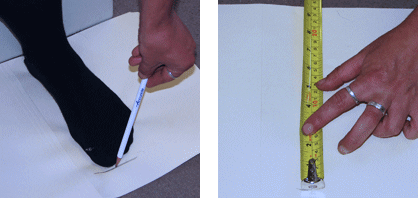Clothing Sizes
1. Measuring for clothing
Every product on our website has detailed sizing information available on the sizing tab but of course that is only useful if you know what size you need to begin with. Here is our guide to measuring yourself or someone else.
Children's clothing is often sized by age but children vary in size so this is only useful as a rough guide. It is invariably better to measure the child accurately and compare to the sizes in the guide.
Not all measurements will be needed for each garment, usually only a couple of simple measurements are needed except for close fitting or tailored clothing.

Stand barefoot with heels, bottom, shoulder blades and back of head against a wall or door frame. Mark off a point which is level with the top of the head and measure down to the ground.
Measure round the neck where the collar sits. Alternatively you can measure a shirt that fits well. Lay the shirt flat, start at the middle of the button and measure to the far end of the button hole.
Measure around the fullest part of the chest and across the shoulder
measure around the natural waist ( smallest part of the waist ), keep the tape measure taut.
With feet together, measure around the fullest part of the hips.
Measure from the inside leg at the crotch to where the hem is to sit on the shoe, alternatively measure a trouser that fits well.
Around the head at the fullest point. For most hats this corresponds to the level the brim will sit.
Across the width of the shoulder tip to tip of collar bone at widest point
From tip of shoulder to wrist, usually measured with a natural bend in the arm to allow for movement without riding up excessively.
Around the fullest part of the bicep/tricep, measure with arm bent to flex muscle.
From waist to outside ankle bone - equivalent to skirt or overall trouser length
Around the fullest part of the thigh
2. Measuring for shoes
Cinderella and her sisters learned the hard way about foot measurement but is really isnt all that difficult. Our guide will show you how.
Measuring feet before purchasing online is a real must. Why ? Well, there is no standard sizing for footwear which makes comparing sizes between manufacturers almost impossible. Thankfully there is the Mondopoint system which is based on foot length in millImeters and simplifies things greatly. We list all footwear with a recommended mondopoint footlength as well as the manufacturers indicated size to give you confidence that our footwear will fit just right first time.

Stand with heel against the wall, put full weight on that foot, and make a mark on a piece of paper where the point furthest from the wall is. Usually this is at the tip of big or second toe.
Do the same with the other foot as most people have one foot slightly larger than the other.
Measure the distance in mm and this is equivalent to the Mondo Size. Choose footwear according to this size. If the length is between sizes or there is a significant difference between feet we suggest always to go for the slightly larger size.
We are quite happy for you to order a couple of different size shoes, simply keep the ones that fit and return the ones that dont.

